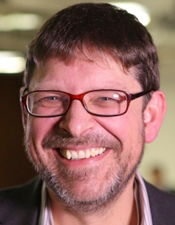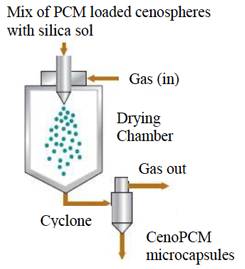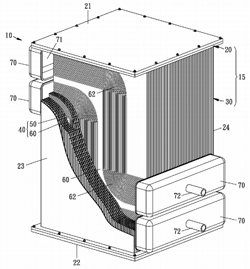 The Phase Change Matters e-mail newsletter is a weekly summary of the latest news and research on phase change materials and thermal energy storage. To subscribe, visit www.puretemp.com/subscribe. For more frequent updates, follow @puretemp on Twitter or visit the Phase Change Matters blog, www.puretemp.com/pcmatters.
The Phase Change Matters e-mail newsletter is a weekly summary of the latest news and research on phase change materials and thermal energy storage. To subscribe, visit www.puretemp.com/subscribe. For more frequent updates, follow @puretemp on Twitter or visit the Phase Change Matters blog, www.puretemp.com/pcmatters.
THERMAL ENERGY STORAGE
Sunamp is thinking big with commercial-scale heat battery
Sunamp Ltd. continues to seek financing to fund development of its commercial-scale heat battery, the SunampCube. The device is designed to store energy generated by wind, solar and other renewable sources, as well as harvest excess heat generated by waste-treatment facilities.
 The Scottish company is in negotiations to use the technology to transport waste heat by barge from the Avonmouth waste processing facility to Bristol for use in the district heating system under construction there. The batteries would be stored in 16 shipping container units, each holding 2 MWh of heat.
The Scottish company is in negotiations to use the technology to transport waste heat by barge from the Avonmouth waste processing facility to Bristol for use in the district heating system under construction there. The batteries would be stored in 16 shipping container units, each holding 2 MWh of heat.
“We have built and tested a number of cells that will be used to build the full-scale device,” says CEO Andrew Bissell. “Each one is a single cell storing 45-50 kWh.”
What type of phase change material is being used?
“It’s a salt hydrate … our own tweak on sodium acetate trihydrate with both a nucleator and a stability enhancer,” Bissell says. “58C melt and freeze points – almost no subcooling or hysteresis. And very cycle stable. We have cycled a test heat battery over 26,000 times with no loss of capacity or degradation in any metric.”
Bissell says the company is working on financing for the project’s next phase.
PATENTS
Microencapsulation of material using cenospheres
U.S. patent application 20170030077 (applicant Board of Trustees, University of Alabama, Tuscaloosa, Ala.):
 “Disclosed are methods for incorporating core materials such as phase change materials or admixtures into building materials like concrete. The methods use cenospheres, which are then etched and loaded with the core material. The composition can also be coated with a thin film. Compositions containing cenospheres loaded with the various core materials are disclosed, as are building materials containing such compositions. … CenoPCMs have several beneficial properties that make them useful for building materials. For examples, the disclosed CenoPCMs can have high stiffness/strength. The cenosphere shell of a CenoPCM has much higher stiffness/strength than a polymeric shell used in existing microencapsulated PCMs. As a result, CenoPCM can endure strong mixing during the manufacturing of the materials, and will not significantly reduce stiffness/strength of the produced materials.”
“Disclosed are methods for incorporating core materials such as phase change materials or admixtures into building materials like concrete. The methods use cenospheres, which are then etched and loaded with the core material. The composition can also be coated with a thin film. Compositions containing cenospheres loaded with the various core materials are disclosed, as are building materials containing such compositions. … CenoPCMs have several beneficial properties that make them useful for building materials. For examples, the disclosed CenoPCMs can have high stiffness/strength. The cenosphere shell of a CenoPCM has much higher stiffness/strength than a polymeric shell used in existing microencapsulated PCMs. As a result, CenoPCM can endure strong mixing during the manufacturing of the materials, and will not significantly reduce stiffness/strength of the produced materials.”
Related: Low-cost, robust microcapsules of phase change materials for thermal active concrete structures [ResearchGate]
TES facility with heat storage and heat release functions
U.S. patent application 20170030656 (applicant SFI Electronics Technology Inc., Taiwan):
 “A thermal energy storage facility for use in heat storage and heat release comprises a heat storage/release mechanism constituted by multiple heat storage/heat exchange units stacked up, each unit at least comprises a heat storage board having parallel grooves for loading phase-change material (PCM) therein and a heat exchange plate having micro-channel groups for heat transfer fluid (HTF) flowed through to exchange heat with the PCM; particularly two or more the thermal energy storage facilities can be worked together by combination in series or/and in parallel to input of thermal energy, absorption of thermal energy and both simultaneously from the PCM, and the thermal energy storage facility capably operating at a heat storage temperature higher than 1200° C. is suited for use in solar thermal power generation system to improve overall efficiency of solar thermal power to reach 35-40%.”
“A thermal energy storage facility for use in heat storage and heat release comprises a heat storage/release mechanism constituted by multiple heat storage/heat exchange units stacked up, each unit at least comprises a heat storage board having parallel grooves for loading phase-change material (PCM) therein and a heat exchange plate having micro-channel groups for heat transfer fluid (HTF) flowed through to exchange heat with the PCM; particularly two or more the thermal energy storage facilities can be worked together by combination in series or/and in parallel to input of thermal energy, absorption of thermal energy and both simultaneously from the PCM, and the thermal energy storage facility capably operating at a heat storage temperature higher than 1200° C. is suited for use in solar thermal power generation system to improve overall efficiency of solar thermal power to reach 35-40%.”
IN BRIEF
• Viking Cold Solutions has posted a video of one of the PCM-based cooling systems installed at Plaza Provision Co.‘s 130,000-square-foot food warehouse in Puerto Rico. Plaza CEO Robert Cimino says the system, installed in 2012, has cut energy consumption by more than 30 percent and paid for itself in less than three years.
• If you had plans to attend BiobasedWorld 2017 in Cologne, Germany, this month, you probably already know: That trade show was canceled a few months ago due to the industry’s “challenging economic environment.” A related show is forging ahead. Bio-Based Live Europe will be held in Amsterdam May 31-June 1. The focus will be on “Process Innovation and Technology” and “Sustainable Products.” Speakers include Freek Snieders, managing director, Croda International; and Jean Luc Dubois, scientific director, Arkema.
• Oak Ridge National Laboratory takes a look at how University of Michigan researchers used a Cray XK7 Titan supercomputer to study melting in two-dimensional systems. Deeper understanding of the process, Oak Ridge says, “could yield insights into surface interactions in materials important to technologies like solar panels, as well as into the mechanism behind three-dimensional melting.”
• The cold chain packaging class developed by Sonoco ThermoSafe’s ISC Labs will be offered at the Cold Chain GDP & Temperature Management Logistics Global Forum in San Diego in May. The all-day session on May 25 will cover the design, development and qualification of temperature-controlled packaging. The conference agenda is available for download.
• Biznews.com reports that chemicals giant Sasol is “back on the expansion trail, seeking out suitable acquisitions.”
• Among the new fabrics on display at the Munich Fabric Start trade show this week: Cordura denim combined with Schoeller phase change material.
• The University of the West of England has installed two Monodraught Cool-Phase hybrid units in the university’s Estates Management Office in Bristol. Monodraught says its PCM-equipped systems have been shown to “use up to 90% less energy than traditional a/c systems.”
• The 12th Conference on Advanced Building Skins, scheduled for Oct. 2-3 in Bern, Switzerland, has issued a call for papers. Possible topics include financial models, new products, advanced design and building performance. The deadline is Feb. 10.
• Pelican BioThermal has announced that its new passive pallet shipper system, Crēdo Cargo, introduced last year, is now available to rent or buy. The reusable bulk shipper uses phase change material cooling panels to maintain temperature ranges +2C to +8C and +15C to +25C.
RESEARCH ROUNDUP
For our full list of recent academic research, see puretemp.com/academic. Here are highlights from the past week:
From Applied Thermal Engineering:• Experimental and numerical study of insulation walls containing a composite layer of PU-PCM and dedicated to refrigerated vehicle
• Development and experimental validation of a CFD model for PCM in a vertical triplex tube heat exchanger
From Construction and Building Materials:
• Recycled additions for improving the thermal conductivity of concrete in preparing energy storage systems
From Journal of Cleaner Production:
• Thermal behavior of indirect solar dryer: nocturnal usage of solar air collector with PCM
From Innovative Food Science & Emerging Technologies:
• Solar still with latent heat energy storage: A review
From International Journal of Thermal Sciences:
• 2-D numerical investigation of melting of an impure PCM in the arbitrary-shaped annuli
From Applied Energy:
• Melting enhancement in triplex-tube latent heat energy storage system using nanoparticles-metal foam combination
From Problemy Eksploatacji:
• A concept of a thermal comfort system with energy storage in structure of the building
From International Journal of Civil Engineering and Technology:
• Impact of Sodium Silicate Pentahydrate as Phase Change Material in Concrete Cubes for Enhancing the Thermal Comfort [pdf]
NETWORKING
Connect with PCM experts and industry leaders on LinkedIn
More than a thousand of your peers have joined a LinkedIn group devoted to the discussion of phase change material and thermal energy storage. The Phase Change Matters group is an interactive complement to the award-winning blog and newsletter of the same name.
 You are invited to join the group and connect with PCM and TES experts from around the world. New members include Alexander Studniorz, research assistant at Technische Universität Berlin, Germany; Nick Gould, process engineer at Novomer Inc., Ithaca, N.Y.; and Dr. Halime Paksoy, associate editor at the International Journal of Solar Energy Society. Halime writes:
You are invited to join the group and connect with PCM and TES experts from around the world. New members include Alexander Studniorz, research assistant at Technische Universität Berlin, Germany; Nick Gould, process engineer at Novomer Inc., Ithaca, N.Y.; and Dr. Halime Paksoy, associate editor at the International Journal of Solar Energy Society. Halime writes:
 “I am a professor of chemistry from Cukurova University, Turkey. I have been the previous chair of International Energy Agency Energy Conservation Through Energy Storage program (IEA ECES). We are going to organize the next 14th International Energy Storage Conference – EnerSTOCK2018 on 25-28 April 2018 in Adana, Turkey. Phase change materials (PCM) is of course included in the topics. We will soon send around the first call for the abstracts. I will come back to you with more information. In the meantime please save the date. We hope to see you all at the conference.”
“I am a professor of chemistry from Cukurova University, Turkey. I have been the previous chair of International Energy Agency Energy Conservation Through Energy Storage program (IEA ECES). We are going to organize the next 14th International Energy Storage Conference – EnerSTOCK2018 on 25-28 April 2018 in Adana, Turkey. Phase change materials (PCM) is of course included in the topics. We will soon send around the first call for the abstracts. I will come back to you with more information. In the meantime please save the date. We hope to see you all at the conference.”